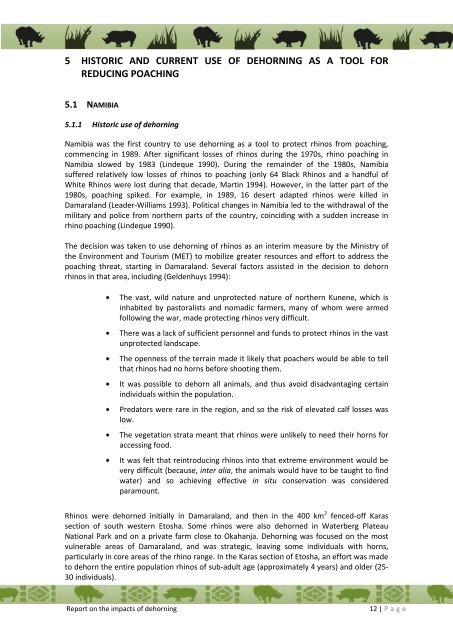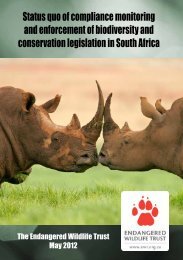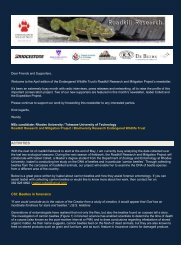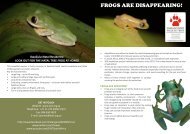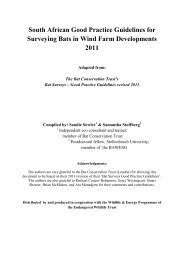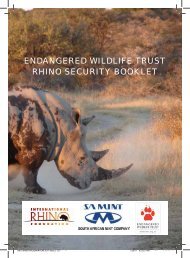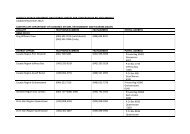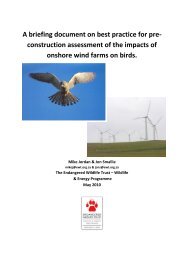click - Endangered Wildlife Trust
click - Endangered Wildlife Trust
click - Endangered Wildlife Trust
You also want an ePaper? Increase the reach of your titles
YUMPU automatically turns print PDFs into web optimized ePapers that Google loves.
5 HISTORIC AND CURRENT USE OF DEHORNING AS A TOOL FORREDUCING POACHING5.1 NAMIBIA5.1.1 Historic use of dehorningNamibia was the first country to use dehorning as a tool to protect rhinos from poaching,commencing in 1989. After significant losses of rhinos during the 1970s, rhino poaching inNamibia slowed by 1983 (Lindeque 1990). During the remainder of the 1980s, Namibiasuffered relatively low losses of rhinos to poaching (only 64 Black Rhinos and a handful ofWhite Rhinos were lost during that decade, Martin 1994). However, in the latter part of the1980s, poaching spiked. For example, in 1989, 16 desert adapted rhinos were killed inDamaraland (Leader-Williams 1993). Political changes in Namibia led to the withdrawal of themilitary and police from northern parts of the country, coinciding with a sudden increase inrhino poaching (Lindeque 1990).The decision was taken to use dehorning of rhinos as an interim measure by the Ministry ofthe Environment and Tourism (MET) to mobilize greater resources and effort to address thepoaching threat, starting in Damaraland. Several factors assisted in the decision to dehornrhinos in that area, including (Geldenhuys 1994):The vast, wild nature and unprotected nature of northern Kunene, which isinhabited by pastoralists and nomadic farmers, many of whom were armedfollowing the war, made protecting rhinos very difficult.There was a lack of sufficient personnel and funds to protect rhinos in the vastunprotected landscape.The openness of the terrain made it likely that poachers would be able to tellthat rhinos had no horns before shooting them.It was possible to dehorn all animals, and thus avoid disadvantaging certainindividuals within the population.Predators were rare in the region, and so the risk of elevated calf losses waslow.The vegetation strata meant that rhinos were unlikely to need their horns foraccessing food.It was felt that reintroducing rhinos into that extreme environment would bevery difficult (because, inter alia, the animals would have to be taught to findwater) and so achieving effective in situ conservation was consideredparamount.Rhinos were dehorned initially in Damaraland, and then in the 400 km 2 fenced-off Karassection of south western Etosha. Some rhinos were also dehorned in Waterberg PlateauNational Park and on a private farm close to Okahanja. Dehorning was focused on the mostvulnerable areas of Damaraland, and was strategic, leaving some individuals with horns,particularly in core areas of the rhino range. In the Karas section of Etosha, an effort was madeto dehorn the entire population rhinos of sub-adult age (approximately 4 years) and older (25-30 individuals).Report on the impacts of dehorning12 | P a g e


